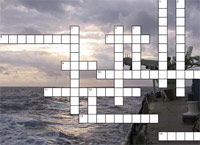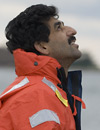|

 Today's Weather Mostly cloudy with showers Lat: 04° 02’S Long: 12° 17’W Air Temp: 77.9°F Bar Pressure: 1009.6 mbar Sea Temp: 79.5°F Sea State: 4-6 ft Swell Height: <7 ft, SE Wind: SE; 13-16 knots Visibility: Unlimited
The First Dive is (Hopefully) the Hardest It felt like the day of a space shuttle launch—although, of course, our medium is the deep ocean, not outer space. By 9:30 a.m. Wednesday, all was ready for Puma’s first big day of the cruise and its launch into the “inner space” of Earth’s deep ocean. Scientists and engineers donned their work vests, hard hats and sturdy shoes—necessary safety attire during deck work—and carried out last-minute preparations. They’d done most of the work late the night before and early into the morning. While Puma recharged its batteries, some members of the team scrutinized graphs of data to check Puma’s performance during its earlier tests. Others checked and rechecked the computer programs that were to guide Puma during its mission this morning. Today was a big day for everyone! A team of eager engineers rolled Puma on its cradle to the stern of the ship, and positioned the AUV under the giant A-frame that will lift it up and lower it into the ocean. While bosun Pete Liarikos attached a special releasable hook and line to an “eye” on top of Puma, engineer John Bailey attached the drop (descent) weight that hangs below Puma and ensures a speedy dive into the deep ocean. With engineers handling the “taglines” attached to Puma to keep it from swinging around, Pete signaled the A-frame operator to lift Puma off the deck. Graduate students pulled its cradle out of the way. It was time for our “cat” to take a swim. The science party watched as Puma drifted away from the stern, sloshing in the waves. All lines were removed, and the drop weight was pushed over the stern. Puma vanished into the depths. Puma was programmed to descend to more than 3400 meters (2.1 miles) below the ocean surface and then swim a series of parallel lines in a box measuring roughly 2 kilometers by 1 kilometer (1.2 miles by 0.7 miles) so that it could map the hydrothermal plume and try to zero in on the vents that are producing it. To help it on its way, the drop weight that Puma carried was to release at a water depth of about 3250 meters, and then the AUV would swim on its own the rest of the way down to its survey depth. Then, something unexpected happened at a depth of only about 700 meters (close to 0.5 mile): Puma’s drop weight somehow released! Because Puma is slightly positively buoyant (in case it ever needs to rise to the surface in an emergency), it drifted upwards. The engineer team decided to let it float to the surface and recover it, rather than wait until it went into “drive” mode and have it swim down to the survey depth for what would have been an abbreviated mission. By 12:30 p.m., Puma was safely back in its cradle on deck—but the crew members were left scratching their heads as to why the drop weight had released. There was no evidence left that provided any clues. The entire tether and weight assembly was gone. And maybe this aborted dive was a blessing in disguise! It turned out that Puma’s long baseline navigation system wasn’t working at all, so if it had made it to its survey depth, it would not have had any navigation. “We knew that long baseline was not working during Puma’s descent,” explained engineer Louis Whitcomb, “but we were not concerned, as it is often unable to ‘hear’ seafloor transponder pings until it’s around 2000 meters deep.” But when they checked the data files on Puma’s return to Knorr, there was not a single long baseline return! There was no navigation data! It’s a bit like turning on your TV and not only is there no picture, but there is no static either. The communications system had not worked. Finally, after about 5 hours working on various possibilities, the source of the problem was finally tracked down. The culprit? A ‘bug’ in the acoustic communications system. By early evening, the engineers had found a work-around to ensure our progress, and Puma took the plunge once more at around 8 p.m. this evening. Join us tomorrow to find out what happened! Read the interview Hanumant Singh: Hanu Singh, an ocean engineer at Woods Hole Oceanographic Institution and leader of the team that built Puma and Jaguar, is the Chief Scientist on the current expedition. Learn more about Hanu, and hear his perspective on why this cruise is important in improving the way research at sea is carried out. Read the interview »
[ Previous day ]
|
||
Mailing List | Feedback | Glossary | For Teachers | About Us | Contact
© 2010 Dive and Discover™. Dive and Discover™ is a registered trademark of Woods
Hole Oceanographic Institution



